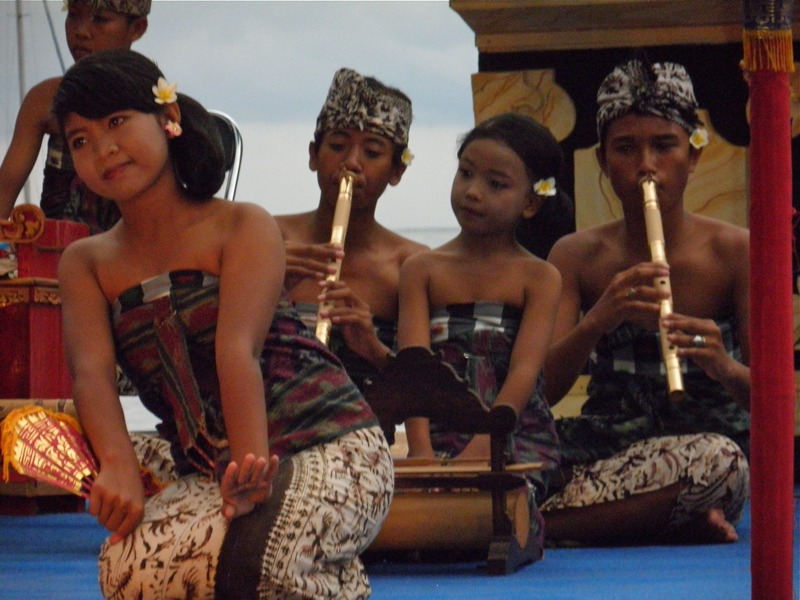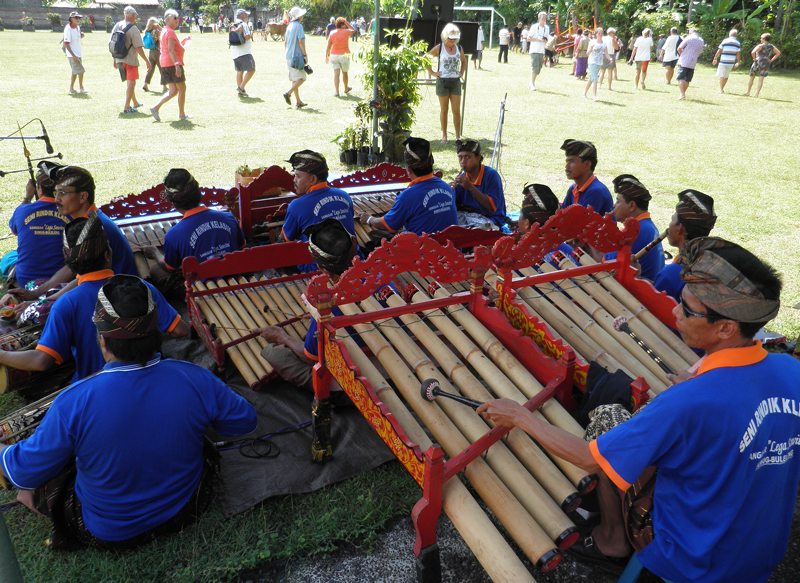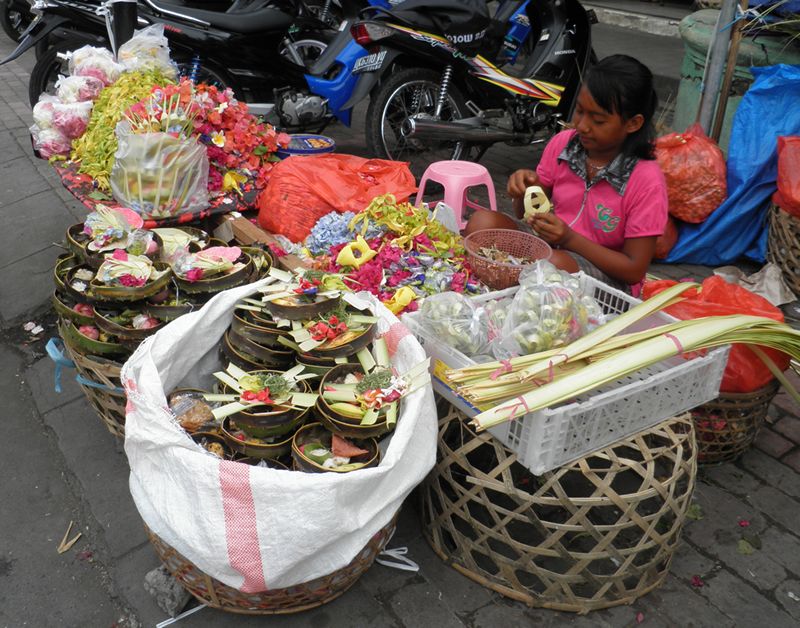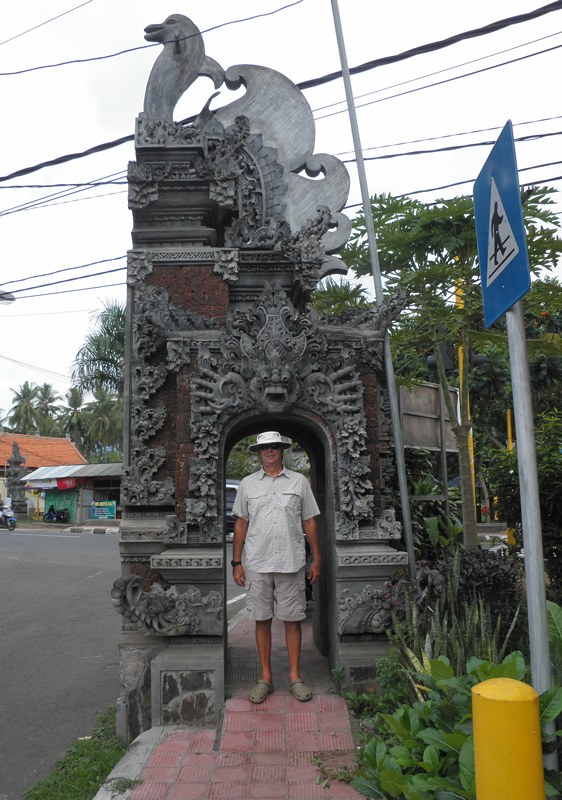More Bali Magic - Lovina Beach, Bali, Indonesia

Harmonie
Don and Anne Myers
Sat 23 Oct 2010 03:17
|
08:09.621S 115:01.149E
We expected the official Sail Indonesia Rally stop in
Bali to be something special and weren't disappointed. It was the
largest gathering of rally boats since Darwin with at least 50 of the 100
rally boats anchored three or four deep along the long stretch of sandy
Lovina Beach. The locals came out in droves on their
motorcycles from the nearby city and surrounding countryside to see the
floating collection of yachts rocking quietly on the leftover northerly
swell. They weren't so much interested in us yachties - being from Bali,
they've all seen their share of tourists - so we didn't generate the usual
excitement. Completely understandable, especially since we aren't much to
look at this far into the boating season with our scraggly hair and crumpled
clothes. The show they put on for us, however, was excellent. The
program lasted four days, during which we were treated to dinners, lunches, a
tour of the area, and entertainment every night on a stage set up specially for
the rally. I think we paid $10 per person for the tour, but the
rest was free, which has been the case throughout our Indonesian travels
with the rally. Aside from the $210 we paid to cover our visas for three
months, we have paid nothing to the Indonesian government. This after
being warned repeatedly about its corrupt nature. Other boaters we
have run into who are not part of the rally have a slightly different tale
to tell. We are pretty sure the rally organizers have more
than a bit of pull with all the local governments and have told them if
they want us to help promote tourism in Indonesia, it would be best not to try
and pad their pockets with our rupiah.
The usual boat boys greeted us upon our arrival at Lovina
Beach on September 22 after a nine hour motoring marathon from Ambat. This
time the boat boy vehicle was a double outrigger sailing canoe (fitted
with a motor) that led us safely past the reef, and later not only
delivered, but helped empty the six 30 liter jerry cans of diesel we
ordered into our tank. After that, they didn't bother us. No more
wooden Komodo dragon carvings or pearl necklaces for us.
Instead, the beach was lined with temporary stalls (put up for our benefit)
filled with the usual Bali wares - sarongs in traditional and not so traditional
Bali prints and men's shirts in very loud patterns and colors. Naturally
we bought one for Don. It was all of $5 and is covered with a
repeating design involving one of the more famous Bali Hindu figures (a
scary-looking dragon/dog's head). Don has already worn it to several
rally functions where it's gone over well, but it
might not fly in Syracuse, NY.
We anchored off Lovina Beach four nights, and then reluctantly
left Bali behind and headed northwest to Borneo and the land of the
orangutans.
 Traditional music and dance performance by kids from the local
orphanage. We didn't realize the kids were from an orphanage until after
the fact. We thought they were just a really talented group of
youngsters who enjoy doing this kind of thing. Hopefully they do
enjoy it, but apparently it's something they do to raise money for the
orphanage. The fifty or so rally boats that were there at
the time got together and donated 6 million rupiah. Not so much
really - only $600, but we were told the orphanage was floored by the amount and
decided almost immediately to use the money to buy a new cow. Yup, a new
cow.
Over the course of the four days, the entertainment took place
on this stage, which was set up on the beach, along with the
obligatory covered seating area for the VIPs (us), not two steps away from where
we beached our dinghies. The stage and seating area were all
done up in the usual Bali fashion - everything perfectly placed, color
coordinated and very pleasing to the eye. Even the small stone statues at
the front of the stage were dressed nicely in traditional waist wraps and black
and white plaid sarongs.
 A close-up of the smallest orphan. She sat next to the
flute playing boys, behind the dancing girls, and kept the rhythm going on
an ornamental wooden percussion instrument while she moved her head
side-to-side in time to the music and the movements of the dancing
girls. I should mention here that we have not seen an ugly person in
Indonesia. As a people, the Indonesians have to be one of the most
attractive in the world. And no doubt the Balinese win the prize
for most beautiful in Indonesia.
 On our last night at Lovina Beach, the local kindergarteners
entertained us. Think ballet recital with more exotic costumes and more
boys, and you'll have it about right. There were several classes that
performed, but this one was our favorite. The chubby little guy to the
right in the back had a habit of leading with his left foot while all the others
went with their right. Completely hilarious. Just like a ballet
recital at home, all the moms in the audience snapped pictures while the
teachers peeked out from behind the set to make sure everything was
semi in control on stage. Later on, some of the older girls and boys
performed a dance more like hip hop than traditional Balinese. If we
didn't already feel like we were in a different country, watching
10-year girls gyrate to hip hop music might have been our first big
clue that we weren't in the Muslim version of Kansas any more.
 Every event we attended was accompanied by traditional
dance. The dancers were always dressed in sarongs and wraps of elegant
materials with different textures and colors. Taken separately,
the mass of colors would clash, but put together on a gorgeous Balinese girl, it
works. Surely there is meaning and history behind each piece of
clothing worn by a traditional Balinese dancer, but not knowing the history, we
could only admire the spectacle.
Balinese dancing reminds us of the South Pacific in the way
that the feet move quietly while the hips sway sedately, but the sometimes
stiff and jerky movements of the upper body (all highly precise
and choreographed) remind us we are now in Asia. Every movement down
to the stiff fluttering of a finger is exact. The facial expressions
and head movements are something else. Sometimes swaying side to side
fluidly with the music, the head will suddenly jerk to a stop while the face
goes blank and the eyes widen, sending the pupils right and left, leaving
those of us in the audience to wonder if the dancer is surprised, frightened or
annoyed. There is usually a story behind every dance, so there is
sure to be a reason for the sudden changes in a dancer's _expression_, but
even without the story knowledge, we were happy enough to watch and
wonder.
 The running of the bulls. Balinese style. A
tradition of North Bali - the bulls are decorated with beautifully painted yolk
and plow, elaborate headgear and bells strapped to their legs, then driven by a
'jockey' to run. We were told the running of the bulls is not about
speed. This is Bali, after all. Instead, the running of the bulls is
about the harmonious nature of the bulls' steps. On a particularly
hot and sticky day, we watched three pairs of beautiful bulls jog
harmoniously, bells jingling, up and down a soccer field with their jockeys
bumping along behind them atop a wooden plank fastened to the
makeshift plow. Once again the deep meaning of the event escaped us,
but it was kind of fun to watch - at least until the bulls started sweating
up a storm, foaming at the mouth and developing bloody sores where the
decorative yolks chafed their skin. Who says the beautiful (and
harmonious) don't suffer for their beauty?
 Every event also included traditional music. This is the
traditional band playing at the running of the bulls. Traditional Balinese
music is usually a collection of percussion instruments like these (although the
orphanage band did had two electric guitars...). The sound is like a
xylophone, and is usually accompanied by drums of various shapes and
sizes. It takes some getting used to, but tends to grow on
you.
 A temple in full dress for the full moon ceremony. A
once-a-year event, the full moon ceremony is big on Bali. This small
temple was a short stroll down the beach from where all the boats were
anchored. We happened by at around 5 pm with Claire and Fiona from English
boat Sa'Vahn. A priest and a few other men were standing nearby and
were nice enough to explain what the ceremony was all about and what was going
to take place that night. While we were talking, a woman sauntered past
with a fruit tower on her head. She was delivering it to the temple where
it, along with the others pictured here, would be offered up to a deity that
night. The men invited all of us to join the ceremony and Claire and Fiona
took them up on their offer. The next day, they reported everyone was more
than friendly and even though they had intended to view the proceedings from the
outskirts of the gathering, the crowd encouraged them inward and they ended up
among the many. They said there was a fair amount of praying going on,
with music and food. They didn't stay until midnight, when the temple
gathering moved to the beach and into a collection of double outrigger sailing
canoes in which offerings were taken out to sea and released to the god of
the sea? (not sure which entity was being honored) to ensure good luck for the
fishermen.
In general, we didn't find the Balinese Hindu religion to be
intimidating at all. Although we were surrounded by aspects of it
almost constantly (the dances, the music, the stone carvings, the temples,
the offerings left underfoot on sidewalks, etc.), the people were happy to share
the celebration of their religion with us without insisting we believe in
it. Very refreshing.
 Offerings for sale at the market. Why struggle to make
your own offering to appease the spirits when you can simply buy one
ready-made? The young girl here is weaving one of the tiny offering
baskets, and will fill it artfully choosing from the piles of flowers and bits
of food in front of her, then add it to the pile for sale in the big lined
basket in the foreground
 We took a tour up into the mountains of northern Bali and
stopped on the edge of this monkey forest long enough to say hi to a monkey mom
and her twins.
 Big man in a little man's world. Elaborately carved
stone gates like this one can be found everywhere on Bali. Many dating
back centuries. The people here are small, but maybe they were even
smaller back then?
Anne
|